This section gives an abstract of each presentation in the order in which they were presented. With one or two minor exceptions, Ministry representatives from each country presented first, then FAO representatives. The papers are discussed in a separate section of these proceedings. The full papers are in Annex 4. The PowerPoint presentations are available on CD ROM or on request from FAO or from the authors (see Annex 2: List of participants)
|
Session 1 |
Past and ongoing activities. Major constraints and future plans |
|
Chairperson for the sessions from 09.35 to 13.30 – Mr Udhoro Kasih Anggoro |
Whilst each country and region has unique social, economic, cultural and geographical features and experiences varied, there were a number of common threads running through the presentations.
|
Maldives |
Ministry of Fisheries, Agriculture and Marine Resources |
|
Fisheries and Agriculture |
Zaha Waheed – Deputy Director, Planning and Coordination Services and Aminath Rishaadh – Assistant Data Processing Officer |
“In a disaster, we need rapid disbursement arrangements, but few donors have the capacity to respond like this.”
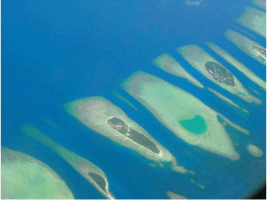
The Maldives is a Pacific archipelago of around 1 200 islands. The population of just under 300 000 people inhabit about 200 of these. Before the tsunami, Maldives was experiencing an average annual growth rate of about 7 percent. Tourism and fisheries were and remain the main industries.
Only nine islands escaped flooding when the tsunami struck. One third of the entire population were affected and it is estimated that 62 percent of the GDP was wiped out by the disaster. The Government immediately established a National Disaster Management Centre to coordinate relief and to gather information. The presentation describes these efforts in detail.
The lack of pre-tsunami data was identified as one of the major constraints in delivering relief, along with the communication and transportation difficulties. A short-term strategy for relief (to June 2005) was formulated and focused on replacing critical infrastructure, micro-financing, replacement of fishing vessels, community development and damage assessment to marine resources. The medium-term plan took recovery planning to December 2006 and focused on rebuilding the fisheries sector.
The presentation offers an informative list of lessons learned, chief among them the value of information management and readiness in terms of capacity to respond to disasters. The Maldives is now formulating a “Safe Islands” programme. The programme will facilitate population movement to larger islands to accelerate social and economic recovery and sustain development. The National Disaster Management Centre is now a permanent institution tasked with preparing a comprehensive National Disaster Preparedness Plan.
|
Thailand |
Department of Agriculture Extension (DOAE), Ministry of Agriculture and Cooperatives |
|
Fisheries |
Anan Lila – Director, Planning Division and Apinan Kamnalrut – National Consultant, FAO |
“The programme was carefully planned with consideration for transition from an early input delivery phase to medium and long-term rehabilitation phases.”
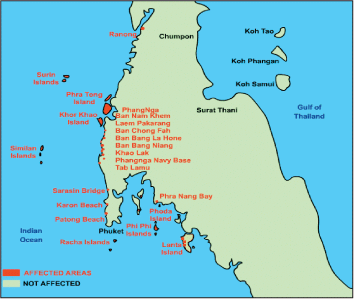
In Southern Thailand, six provinces were affected by the tsunami. Over 5 000 people died, many of them visitors to Thailand. Over 100 000 people were directly affected. This presentation outlines the Royal Thai Government – FAO institutional response and details of the Department of Agriculture and Extension response. Factors contributing to the success of programme responses include:
In the reconstruction phase there is an emphasis on self-reliance and income generating activities as illustrated by the hydroponics gardening project. Ongoing development is being supported by a five-year regional project funded by the Japanese Government. The project will emphasize the long-term continuity of post-tsunami rehabilitation projects and an integrated development approach in agriculture, fisheries and forestry.
|
Sri Lanka |
Ministry of Agriculture |
|
Agriculture |
Shantha Emitiyagoda – Deputy Director Extension, Department of Agriculture |
“There was difficulty in collecting information soon after the tsunami as some farmers were displaced and were in a temporary camp at the time of data collection."
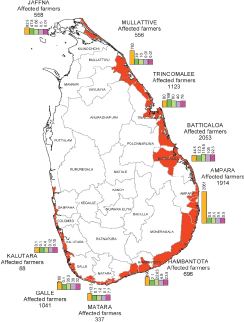
This presentation describes some of the difficulties involved in gathering much needed data un post-disaster conditions. Based on this experience, the author offers a number of useful pol implications regarding:
|
Indonesia |
Ministry of Agriculture |
|
Agriculture |
Udhoro Kasih Anggoro - Executive Secretary, DG of Food Crops |
"Information tends to come from formal institutions but is needed from the field."

In this presentation, the author describes how in February 2005, the Ministry of Agriculture developed a five year plan for agricultural rehabilitation and reconstruction for the people of NAD and Nias (R3MAS) and its three components:
Information management and coordination activities are described in detail. The main obstacles are noted and recommendations offered.
|
Obstacles |
Recommendations |
|
Information tends to come from formal institutions but is needed from the field. Institutional reorganization, language barriers and inadequate infrastructure are obstacles to coordination. Uncoordinated "cash for work" programmes can cause problems. Ethnic minorities have special needs that require specific strategy and policy approaches. |
Empower communities to build sustainable rural networks. Have information on the socio-cultural dimensions of coastal areas. Translation facilities should be expanded, so that both local and international parties can contribute to the key deliberation processes. |
|
Thailand |
Past and ongoing joint activities of DOF-FAO in post-tsunami rehabilitation programmes and achievements in fisheries sector in Thailand |
|
Fisheries |
Department of Fisheries, Ministry of Agriculture and Cooperatives Waraporn Prompoj – Chief of International Cooperation Group and Suchint Deetae – National Fisheries Consultant, FAO |
“All 28 beneficiary groups set up separate revolving fund accounts for loan repayments. As of July 2006, more than half of the groups had made repayments in accordance with the targets.”
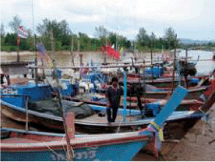
The tsunami caused severe damage to coastal communities in six provinces on the Andaman Sea of southern Thailand. In the fisheries sector, 900 large vessels and 6 500 small fishing boats were lost.
Over 1 800 fisher families received emergency supplies of fishing inputs and restarted fishing activities. The majority of beneficiaries (89 percent) reported monthly average incomes of 4 000-8 000 Baht (US$100-200) more in earnings than before the tsunami.
Post-tsunami problems were mainly related to increased fuel and living costs, lower income from fishing, uneven distribution of aid, lack of coordination between aid agencies, conflicting land use right, physical alteration of coastal areas, and increasing number of fishers. Difficulties encountered in the implementation phase of the projects included:
Based on these experiences, it was suggested that government policies should promote:
|
Indonesia |
Strengthening government’s role in information management and coordination mechanisms in the fisheries sector rehabilitation programme in NAD and Nias post-tsunami |
|
Fisheries |
Ministry of Marine Affairs and Fisheries Hadimulyo Mulyono – Assistant Minister on Cooperation and Inter-agency Relations |
“We need to look beyond replacement to sustainable solutions, not just “building back better” but building a better Aceh.”

The background section outlines the institutional context of the Programme Management Unit and Task Force set up to coordinate assistance, its role and the main agencies involved. The principles and strategies for rehabilitation and reconstruction are outlined, followed by a brief description of the phasing. Budget and project details, key issues, and best practices are listed. The final two slides offer practical suggestions for development in the years ahead. One of major recommendations is to look beyond replacement to sustainable solutions; i.e. not just “building back better”, but building a better Aceh.
|
Indonesia |
Rehabilitation of degraded forest and land in tsunami affected areas in Indonesia |
|
Forestry |
Ministry of Forestry Saeful Rachman – Directorate General of Land Rehabilitation and Social Forestry |
“Mangrove and coastal forests protect people and assets from costal hazards. Therefore, their rehabilitation is an important activity in tsunami affected areas in Indonesia.”
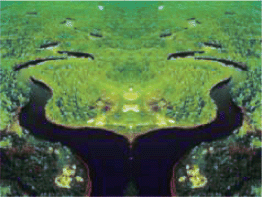
There are 9 million hectares of mangrove forest in Indonesia. The Board of Rehabilitation and Reconstruction (BRR) of Aceh-Nias (2006) estimates the tsunami caused an additional 105 000 ha of damage to mangrove forest and 67 000 ha of coastal forest. Since the disaster, the Ministry has taken a number of actions, including: improvement of data and information gathering, training for local staff of government and non-government organizations, local communities; rehabilitation of degraded state forest and community lands; improved coordination among institutions involved in forest rehabilitation and forestry sector development; and a National Strategy for Mangrove Management. Some of the elements of this strategy include: raising awareness and capacity building of stakeholders; developing information networking among stakeholders; establishing provincial, district and city spatial plans including protection zones and green belt along coastal areas; developing an integrated coastal development master plan, management plan and site technical designs involving local people; and developing clear rules of the game among stakeholders in implementing coastal forest management.
|
Sri Lanka |
Information management and coordination for better livelihoods in relation to forestry in tsunami affected areas |
|
Forestry |
Ministry of Forestry P.A.G.S. Nandakumara – Assistant Conservator of Forest, Forest Department |
“To improve the livelihoods of the tsunami affected population, information gathering and management and effective coordination mechanisms with all stakeholders are essential requirements.”
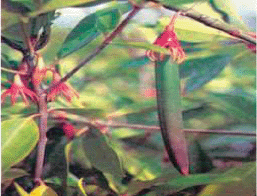
This presentation offers an informative and detailed overview of the extent of mangrove forests in Sri Lanka, the benefits mangroves provide to a wide range of stakeholders and the extent of the damage caused by the tsunami.
The vision of the forestry department is sustainably managed forest and tree resources for providing environmental services and meeting needs of forest products for the country while contributing to the national economy and well being of the people. For each of its objectives (protection, production, benefits to the economy and benefits to communities), the department has identified specific information needs.
|
Thailand |
Post-tsunami rehabilitation in the forestry sector in Thailand |
|
Forestry |
Department of Marine and Coastal Resources, Ministry of Natural Resources and Environment Sonjai Havanond – Coastal and Mangrove Resources Management Expert |
“A 100 meter belt of dense mangroves would absorb enough wave energy to mitigate further inland damage.”

In Thailand’s coastal provinces, a rapid assessment of the damage caused to coral reefs, sea grass beds and mangroves forests indicated direct economic losses of over 30 million US dollars. In collaboration with FAO, UNDP and a number of Thai government agencies, the Department of Marine and Coastal Resources responded with programmes for immediate impact assessment of ecosystems and biodiversity and coastal habitats; action plans to rehabilitate and improve coastal resources and evaluation of innovative rehabilitation techniques including demonstration sites for reef rehabilitation and reforesting mangroves and beach forests, and marine park management focusing on land use control and sustainable tourism development. Activities were undertaken in the areas of ecological studies, economic studies, Remote Sensing and GIS training programmes, public awareness campaigns, a national workshop and formulation of a long-term rehabilitation framework and action plan. The main needs and requirements for future management of coastal natural resources were identified as: strategic management (top down vs. bottom up, people’s participation); information (research and development, baseline surveys, databases, GIS); a community-based management plan; and ecosystems based co-management.
|
Sri Lanka |
Livelihoods recovery: The role of RADA and the income recovery programme |
|
Coordination |
Reconstruction and Development Agency (RADA) M. Mazahim Hanifa – Livelihood Economic Recovery Officer |
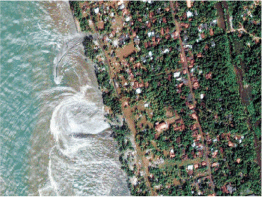
An estimated 35 000 people died in the tsunami in Sri Lanka. Another million were displaced and over 200 000 livelihoods affected. In response to the disaster, the Government created the Reconstruction and Development Agency (RADA) by merging the Task Force to Rebuild the Nation (TAFREN) and THRU, “...to carry out reconstruction and development work of the district affected by human made or natural disasters cost effectively and expeditiously”. RADA has a broad mandate to develop and execute action plans for reconstruction and development work, to implement appropriate relief measures for livelihoods improvement, promote investment and liaise with line agencies, Government authorities, private sector organizations, non-governmental organization and other relevant agencies.
Toward this end, Divisional Livelihoods Development Plans are designed to be needs-based, participatory and inclusive. Some of the key characteristics and outcomes of these plans are provided in the presentation.
|
Indonesia |
Information management and coordination mechanism of the tsunami emergency and rehabilitation operations in agriculture, Fisheries and Forestry |
|
Coordination |
Rehabilitation and Reconstruction Agency (BRR) for NAD-Nias Said Faisal – Deputy for Economic and Business Development |
“At the time a common metaphor used to describe BRR’s position was: We are building the ship while sailing on the seas.”
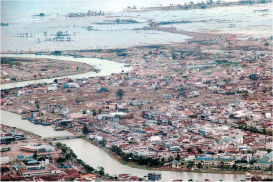
In Ache, the tsunami affected 1 500 villages in 15 districts along 800 km of coastline. Over 60 000 ha of agricultural land were damaged and over 220 000 people had to rebuild their lives and livelihoods. As part of the ongoing recovery process, the Rehabilitation and Recovery Agency (BRR) was established in April of 2006. Its mission: to restore livelihoods and strengthen communities in Aceh and Nias and to coordinate and implement rehabilitation and reconstruction projects in the region.
This presentation outlines the implementation and coordination process and provides details on spending and progress towards programme targets in the three sectors. The section on Information Management outlines the RAND database, how it is used for collecting, tracking, analysing and displaying project and funding information, the reporting requirements and reporting process, and the benefits of using the system.
The coordination section of the presentation describes four significant developments: Concept Note Process, Portfolio Management, Regional Management, and Lead-donor Roles in the recovery phase.
|
Session 2 |
Role of FAO in coordination of the emergency and rehabilitation operations and achievements – Inventory of the data collected in AG, FO and FI |
|
Chairperson for the sessions from 15.30 to 17.20 – Waraporn Prompoj, Thailand |
|
Thailand |
Post-tsunami rehabilitation coordination and information management in Thailand |
|
FAO |
FAO Thai Affairs Section (TAS) and Department of Fisheries (DOF) Simon Wilkinson – Communications Manager, NACA and Waraporn Prompoj – Chief of International Cooperation Group |
“It quickly became apparent that information collection mechanisms and skills had to be improved.”

Following the tsunami, concerns grew over the status of coastal fisheries, fish stocks, duplication of effort and lack of coordination in distribution of fishing inputs, and the growing need for information on the distribution of fishing inputs to facilitate coordination and informed decision making.
The major outcome of a DOF-FAO convened donor coordination meeting with 60 participants from 26 organizations was the Rehabilitation Information Unit within the DOF. The Unit’s main aims are to provide information on the status of fisheries resources, fishing capacity and the distribution of key fisheries inputs, a contact database and a project database of rehabilitation activities. It quickly became apparent that information collection mechanisms and skills had to be improved at provincial and district level. FAO was instrumental in helping establish provincial rehabilitation information units, technical assistance, capacity building and links between units.
Another important outcome of this project is the DOF-FAO Andaman Forum website. The site has been expanded to support information on the agriculture, livestock and forestry sectors and is aiming to become a ‘one stop shop’ or clearing house for post-tsunami rehabilitation information.
|
Maldives |
FAO ERCU: Achievements of FAO project OSRO/RAS/505/CHA |
|
FAO Coordination |
James Terjanian – Information Management Specialist, FAO Maldives |
“Coordination is possible only to the level of interest of the least interested actor.”
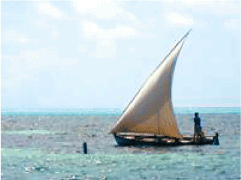
The Maldives comprises a chain of 1 190 islands and has a population of just under 300 000 people. Whilst the loss in human life was low compared to other countries, it is estimated that the tsunami wiped out 62 percent of the GDP of the Maldives and growth in 2005 was minus 5 percent. FAO coordinated US$4.7 million in funding from Belgium, China, FAO, Finland, Japan, OCHA, Trinidad and Tobago and UNDP. The funds were spent on seven country projects and two regional projects over a period of 19 months.
The main constraints faced by the project team were: inadequate human resources, deficiencies in database and planning, beneficiary targeting, inadequately developed systems for sectoral coordination, complex sea logistics and the wide dispersion of beneficiaries, and high sea transport costs. Before the tsunami, there was little information available and low levels of staff capacity for information management in the three sectors. Some of the major lessons learned:
|
Sri Lanka |
FAO in post-tsunami rehabilitation of fisheries, agriculture and forestry sectors in Sri Lanka |
|
FAO Coordination |
Leslie Joseph – National Consultant, FAO |
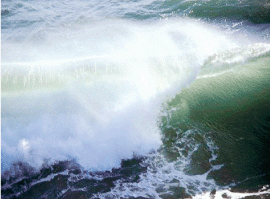
FAO assisted with a wide range of emergency relief and monitoring and coordination activities in the agriculture, fisheries and forestry sector in Sri Lanka. Based on these experiences, FAO has identified the following issues and challenges in coordination and monitoring:
|
Issues |
Challenges |
|
|
|
Indonesia |
Information flow and coordination mechanisms in rehabilitation work in Aceh: An overview of the FAO role |
|
FAO Coordination |
Sugianto Saman – FAO Rehabilitation Support Coordination Unit, Banda Aceh |
“Small support from a donor like FA O can have a big impact on information and coordination of rehabilitation efforts.”
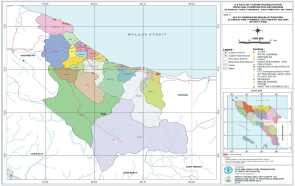
Information and coordination are two important keys in delivering rehabilitation work in Aceh. To deal with the disaster, a review of national capacities in relation to coordination structures must take into account the sectors worst hit and the urgent need for capacities to coordinate, monitor and plan livelihoods rehabilitation. A better and more secure future for the affected people now depends on well-coordinated, integrated and participatory planning efforts at national, provincial and local levels.
Some of the problems identified were: information gaps and lack of key performance indicators, no clear concept for subsector planning and monitoring, inadequate information management systems and coordination and a lack of spatial planning and spatial information.
Conclusion of Day 1
Dr Gamini Keerthisinghe thanked the participants for their informative presentations and expressed appreciation to those who acted as Chairpersons during the day. Mr Merkur Beqiri then outlined the process for group discussion on Day 2. Participants were invited to attend a reception dinner at the hotel.